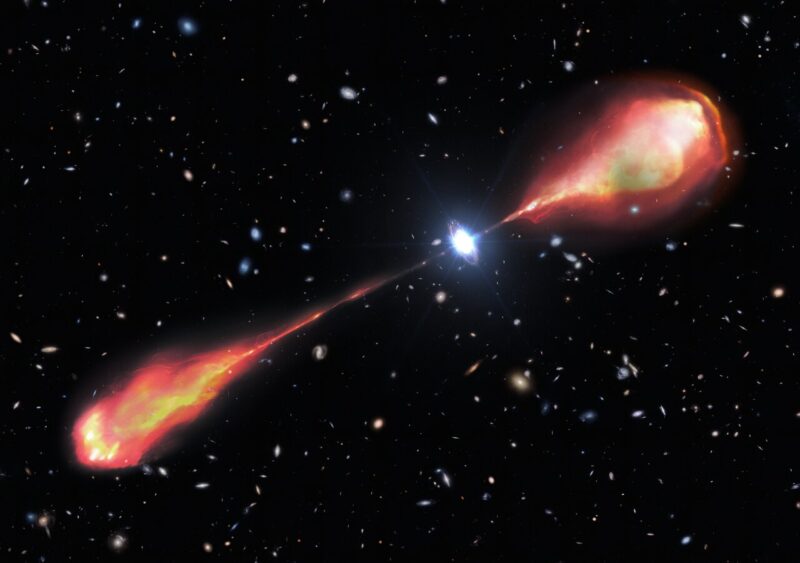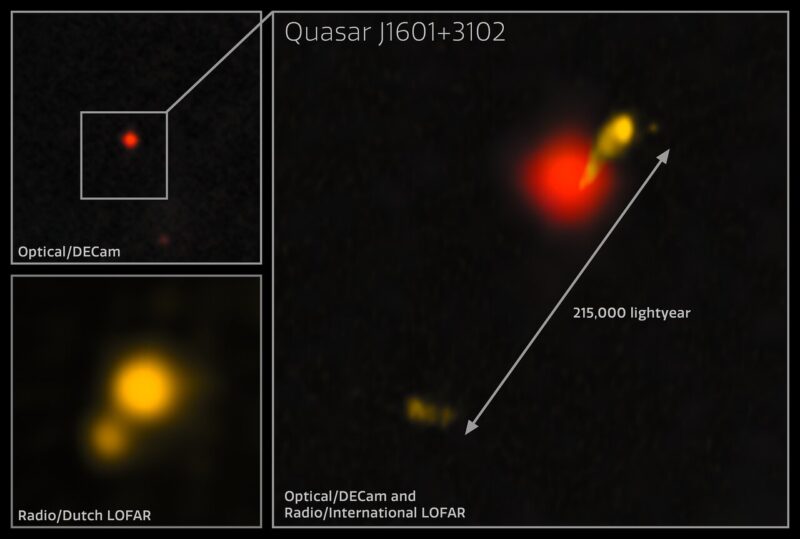Watch this video of the largest radio jet that astronomers have seen yet in the early universe. Image via NOIRLab.
Largest radio jet seen yet in the early universe
In the nearby universe, astronomers have seen many radio jets blasting outward from the black holes at the cores of galaxies. But on February 6, 2025, researchers with NOIRLab in Arizona said they’ve spotted the largest radio jet yet in the early universe. This two-lobed jet is twice as long as the Milky Way galaxy at some 200,000 light-years. We’re seeing this jet from when the universe was less than 1.2 billion years old, or just 9% of its current age.
The researchers published their peer-reviewed research in The Astrophysical Journal Letters on February 6, 2025.
Observing the radio jet in multiple wavelengths
The astronomers used a number of telescopes specializing in different wavelengths to make the discovery and follow-up observations. They first spotted the jet with radio telescopes spread throughout Europe that make up the Low Frequency Array (LOFAR) Telescope. Then they looked in the near-infrared with the Gemini North telescope in Hawaii. And finally they looked at the optical component with the Hobby Eberly Telescope in Texas.
Jets from a quasar
The radio jets emanate from an active young galaxy, or what astronomers call a quasar. Lead author Anniek Gloudemans of NOIRLab said:
We were searching for quasars with strong radio jets in the early universe, which helps us understand how and when the first jets are formed and how they impact the evolution of galaxies.
Understanding more about quasars – these active, young galaxies with central black holes that often emit jets – can help us get a peek at the surrounding environment. This quasar with its impressive radio jets provides some insight to the early universe. The press release said:
The double-sided jets are asymmetrical both in brightness and the distance they stretch from the quasar, indicating an extreme environment may be affecting them.
Gloudemans added:
Interestingly, the quasar powering this massive radio jet does not have an extreme black hole mass compared to other quasars. This seems to indicate that you don’t necessarily need an exceptionally massive black hole or accretion rate to generate such powerful jets in the early universe.
Seeing into the distant past
Astronomers thought the reason they didn’t previously see large jets in the early universe was due to the Big Bang. They thought the leftover cosmic microwave background acted like a fog to hide distant radio sources. Gloudemans said:
It’s only because this object is so extreme that we can observe it from Earth, even though it’s really far away. This object shows what we can discover by combining the power of multiple telescopes that operate at different wavelengths.
Co-author Frits Sweijen of Durham University added:
When we started looking at this object we were expecting the southern jet to just be an unrelated nearby source, and for most of it to be small. That made it quite surprising when the LOFAR image revealed large, detailed radio structures. The nature of this distant source makes it difficult to detect at higher radio frequencies, demonstrating the power of LOFAR on its own and its synergies with other instruments.
The scientists would still like to know how the quasar came to have such powerful radio jets. And also they’d like to learn when the universe’s first radio jets formed.

Bottom line: Astronomers have uncovered the largest radio jet in the early universe. It’s twice the size of the Milky Way and existed when the universe was 9% of its current age.
Source: Monster Radio Jet (>66 kpc) Observed in Quasar at z ~ 5
Source link
Read More
Visit Our Site
Read our previous article: Space weather scales are outdated and confusing. Here’s what NOAA scientists are doing about it.
